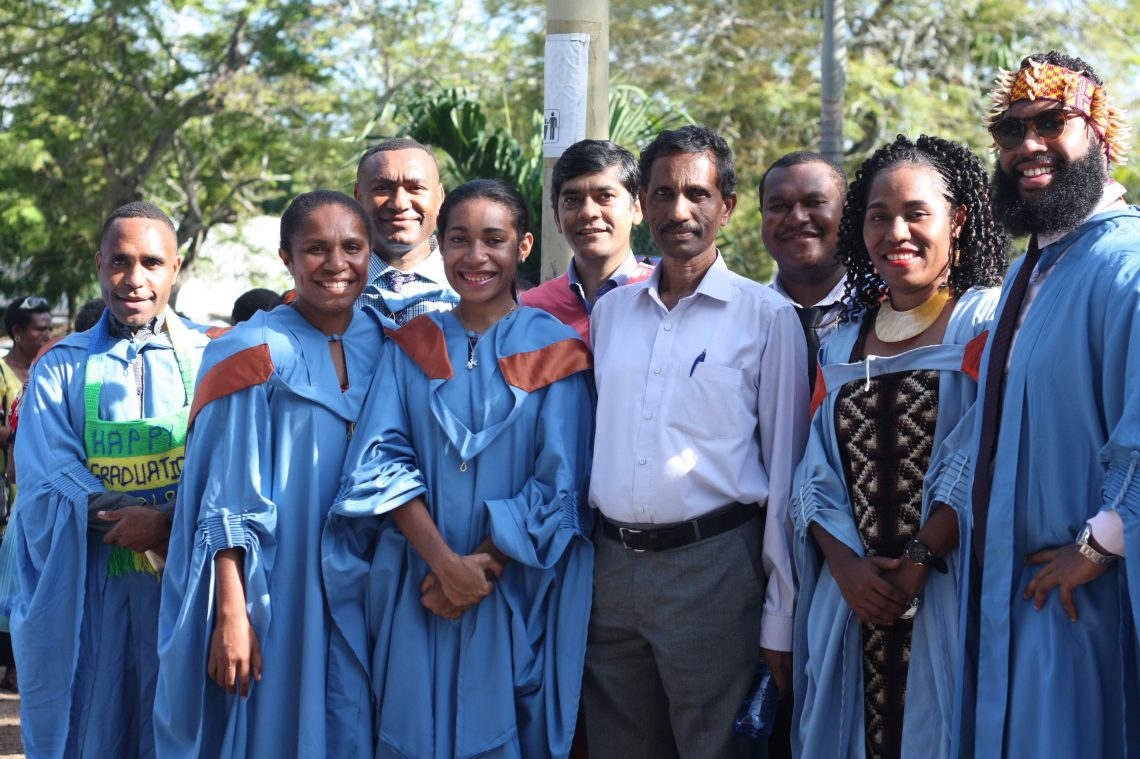
Students and staff at the UPNG graduation in 2018
PNG’s Higher Education Loan Program: in need of help
By Moses Sakai
14 September 2020
As I highlighted in my first blog on this subject back in February, Papua New Guinea introduced its first tertiary loan scheme, the Tertiary Education Students Assistance Scheme (or TESAS) in 1999. It was suspended from 2007-2009 due to a complete lack of repayment by the loan recipients. In 2010, TESAS was reinstated as a merit-based scholarship covering 75 per cent of the total tuition fees with benefits that included airfares (both ways) and pocket and book allowances especially for those students who have performed well academically.
The Marape government introduced the Higher Education Loan Program or HELP in late 2019. It was one of the priorities of Marape-Steven government detailed in Marape Manifesto launched on 16 September 2019. On 17 December 2019, HELP was approved by the National Executive Council with initial funding of 230 million kina (US$67 million). Implementation started in January 2020. Since then, some progress has been made but there is also a lot of confusion building up, which could cause problems for HELP, and perhaps make it suffer the same fate as the first loan scheme.
On the positive side, students have been assisted to obtain a National Identification (NID) card, which is one of the prerequisites for obtaining HELP. As a result of a Memorandum of Partnership between PNG Civil and Identity Registry Office and the Department of Higher Education, Research, Science and Technology (DHERST), special desks were set up in each of the 17 branches of PNG Civil and Identity Registry Office throughout the country to serve tertiary students. In addition, NID offices were also established at the start of the academic year at PNG’s three main universities: University of Papua New Guinea in Port Moresby, University of Technology in Lae and Divine Word University in Madang.
It was reported in February that more than 10,000 tertiary students from the main public and private universities and other recognised small publicly and privately run institutions nationwide had already registered for a NID to obtain the HELP loan between January and February 2020. Some of these students were TESAS students who applied for HELP to pay for the remaining 25 per cent of the tuition fees while others are non-TESAS students who applied for full tuition fees. Since HELP is a non-compulsory facility, the decision to obtain a loan lies with students and their parents or guardians.
To apply for a HELP loan, interested student applicants were issued ‘declaration forms’ by their respective Higher Education Institutions (HEIs). The approval of applicants for the HELP loan is to be made by their HEI, following which DHERST would approve the transfer of funds to the respective HEI.
At the University of Papua New Guinea, for instance, students have been told to fill in the declaration form and attach with it the copies of their NID, admission letters (if they are first years) and transcripts (if they are continuing students). Applications are to be submitted to the Registrar for screening and approval. Applicants also need to provide original copies of their grade 10 and 12 certificates, FODE certificates (if they have upgraded through Flexible and Open Distance Education), NID and 2020 student ID. Upon confirmation of their original documents, applicants have been issued their login credentials to apply online and fill in all their details as required by the DHERST.
All this sounds like good progress but what is not clear yet though is whether funds have actually been transferred under HELP from DHERST to the HEIs. The budgeted funding of K230 million is generous, but PNG is facing major fiscal stress due to COVID-19. Recent protests by Port Moresby Technical College students suggests that not all students will be fully funded.
Another problem is that there has been no indication of the terms and conditions on which these loans have been provided. The Prime Minister earlier said that interest will not be charged, but when do the loans have to be repaid? Is it only if the graduate’s income reaches a certain level? If so, what level, and at what rate? No details of this can be found on the DHERST website, or anywhere else, as far as I can tell. Nor is there any information on how loans will be repaid. Will it be through the tax system or financial institutions?
While it is good to see the interest in the HELP program, it is regrettable that the scheme has begun before the details have been announced. HELP recipients will likely argue that since no one informed them of the repayment requirements, they are not obliged to repay their loans. The first loans could well be due next year, once students start to graduate. If repayments are made through the tax system, has the Internal Revenue Commission started planning for it?
In the TESAS loan program, over 7,000 recipients borrowed 6.6 million kina from 2000-2007 but only one paid the money back. HELP risks suffering the same fate unless it is made clear to loan applicants when and how they are meant to pay back the money before they take out the loan.
I concluded my first blog by arguing that “clarity, preparation and coordination among government implementing agencies will be key” to this second loan program working better than PNG’s first. So far, the signs are not looking good.
About the author/s
Moses Sakai
Moses Sakai is a Research Fellow at the Papua New Guinea National Research Institute. He taught at the University of Papua New Guinea from 2018-2023.
